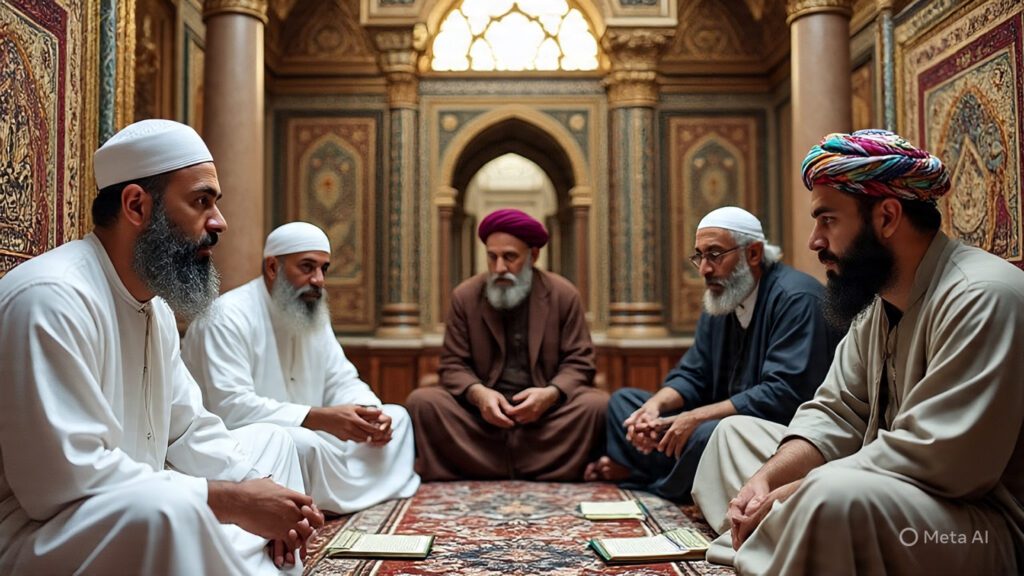Introduction: Self-Knowledge vs. Knowledge of Purpose
In today’s world, self-knowledge is often celebrated as the pinnacle of personal development. We’re encouraged to dig deep, to analyze our personalities, and to explore our personal preferences. But from a traditional Islamic viewpoint, especially within paths that emphasize the teachings of the Qur’an and Sunnah, true self-knowledge is found not in analyzing ourselves in isolation but in understanding our role within the larger context of Allah’s creation.
This post explores four significant paths within Islam that each lead to worshipping Allah by following the example of Rasulullah (s.a.w.): the Four Imams (Madhabs), Salafism, Sufism, and the Ahl al-Hadith. While each path shares a devotion to strictly following the Qur’an and Sunnah, they each approach the journey in unique ways, often resulting in differing opinions on practice and interpretation.
Understanding these differences offers us insight into the diversity of Islamic thought, yet reminds us that these paths, though varied, ultimately converge in devotion to Allah and the example of His Messenger (s.a.w.).
Path 1: The Four Imams – The Schools of Jurisprudence (Madhabs)Overview
The Four Imams—Imam Abu Hanifa, Imam Malik, Imam Shafi’i, and Imam Ahmad ibn Hanbal—developed four schools of Islamic jurisprudence. Each school of thought, or madhab, provides a structured methodology for understanding and practicing Islam. They emphasize practical application, offering guidance on everything from personal worship to societal issues. Despite minor differences in interpretation, each madhab is deeply rooted in the Qur’an and the Sunnah.
How the Four Imams Lead to Following Rasulullah (s.a.w.)
The Four Imams modeled their teachings on the life and actions of Rasulullah (s.a.w.), holding his Sunnah as the ultimate example. They developed legal frameworks that would allow Muslims to live according to Islamic principles regardless of time and place, emphasizing that every ruling must be supported by the Qur’an and Hadith.
Path 2: Salafism – Returning to the Foundations
Overview
Salafism is a movement focused on returning to the earliest practices of Islam, seeking to emulate the lifestyle of the Prophet Muhammad (s.a.w.), his companions, and the following two generations. Salafis avoid innovations (bid’ah) that emerged after this period, maintaining that only the practices of the “Salaf” (the early Muslims) are pure and correct.
Core Principles of Salafism
- Strict Adherence to Qur’an and Sunnah: Salafis strive to follow Islam exactly as it was practiced in the earliest generations.
- Rejection of Innovations (Bid’ah): Innovations are seen as deviations from authentic practice.
- Literal Interpretation: Salafis often avoid metaphorical or abstract interpretations, adhering closely to the original texts.
Path 3: Tasawwuf (Sufism) – The Spiritual Journey
Overview
Tasawwuf, or Sufism, emphasizes spiritual purification and deepening one’s relationship with Allah. For Sufis, worship goes beyond legalistic practice and focuses on the inner dimension of faith, encouraging Muslims to worship as if they see Allah before them. Sufis follow a path of inner development, often under the guidance of a Shaykh, or spiritual master, who helps them cultivate sincerity, humility, and closeness to Allah.
Core Principles of Tasawwuf
- Heart Purification: Sufis focus on removing worldly desires to purify the heart.
- Love for Allah and His Messenger: A core tenet of Sufism is deep love for Allah and His Prophet (s.a.w.).
- Guided Spiritual Path: Sufis often seek a Shaykh’s guidance to ensure they follow an authentic and balanced spiritual path.
Path 4: Ahl al-Hadith – Scholars of Hadith
Overview
Ahl al-Hadith, or “People of Hadith,” is a movement that emphasizes the importance of adhering closely to the Prophet’s sayings and actions. This path relies on Hadith as the primary source of guidance after the Qur’an, advocating for a literal understanding of the Prophet’s words. Ahl al-Hadith scholars typically avoid interpretive methods that extend beyond the texts, aiming to apply every teaching of the Prophet as closely as possible to how it was originally practiced.
Core Principles of Ahl al-Hadith
- Prioritization of Authentic Hadith: Ahl al-Hadith followers rely on rigorously authenticated Hadith as a primary source of guidance.
- Literal Interpretation: Like Salafism, Ahl al-Hadith often takes a literal approach to interpretation, without room for added reasoning.
- Avoidance of Madhab Influence: Ahl al-Hadith followers typically avoid the influence of the madhabs, preferring to derive rulings directly from Hadith.
Differences in Opinion and Practice
| Path | Main Focus | Differences with Other Paths |
|---|---|---|
| Four Imams | Structured legal frameworks and adaptability | Salafis and Ahl al-Hadith might see reliance on madhabs as potentially adding complexity or innovation. |
| Salafism | Return to earliest practices, rejection of innovations | Sufis emphasize inner transformation and might include practices that Salafis consider bid’ah (innovation). Madhabs are sometimes seen as unnecessary by Salafis. |
| Tasawwuf | Spiritual purification, inner worship | Salafis and Ahl al-Hadith might view some Sufi practices as unnecessary or even as innovations. |
| Ahl al-Hadith | Literal adherence to Qur’an and Hadith | Ahl al-Hadith followers often reject madhabs, preferring direct application of Hadith, which can contrast with the structured frameworks of the Four Imams. |
The irony of differences among these paths often lies in each group’s sincere belief that their interpretation is the most faithful way to worship Allah and follow the Prophet (s.a.w.). Though all Muslims strive to uphold the Qur’an and Sunnah, their differences stem from interpretations, methodologies, and emphasis on certain aspects of the teachings. Let’s break down why this happens, despite the shared ultimate goal:
1. Differences in Interpretation of the Sunnah
- What It Means: Each path prioritizes different aspects of the Prophet’s life, leading to varying practices and interpretations.
- Why It Causes Friction: A Salafi, for example, might emphasize outward adherence to the Prophet’s actions, while a Sufi might prioritize inner spiritual development. Each approach sees the Prophet’s example in a unique light, and it’s easy to view another approach as incomplete or “missing the point.”
2. Approach to Religious Texts
- What It Means: For example, Ahl al-Hadith often rely on literal interpretations of Hadith, while followers of the Four Imams (the madhabs) might take a contextual approach, considering scholarly consensus and reasoning.
- Why It Causes Friction: Literalists might feel that a contextual approach risks “watering down” the original teachings, while the madhabs might view literalism as overly restrictive. Each side worries that the other’s approach doesn’t fully capture the depth or flexibility of Islam.
3. Fear of Innovation (Bid’ah)
- What It Means: Salafis and Ahl al-Hadith tend to be cautious about practices they see as innovations not directly supported by the earliest generations, while Sufis or madhab followers might incorporate practices they see as spiritually beneficial, even if newer.
- Why It Causes Friction: Salafis or Ahl al-Hadith followers often worry that innovations could corrupt the purity of the faith, while others believe their practices enrich their devotion without compromising core beliefs.
4. Authority and Authenticity
- What It Means: Who has the authority to interpret the Qur’an and Hadith? The madhabs often rely on centuries of scholarly work, while others, like Salafis, prefer returning directly to the texts without intermediaries.
- Why It Causes Friction: Some view reliance on past scholars as a wise use of collective knowledge, while others see it as potentially limiting fresh interpretations. This difference in perceived authority can lead to mistrust and disagreement over “who’s following the true Islam.”
5. Concerns Over Identity and Community
- What It Means: Each path often becomes a part of its followers’ identity, a way to belong to a community with shared values.
- Why It Causes Friction: When a practice or belief feels central to one’s identity, criticism can feel deeply personal. It can become easy to fall into an “us vs. them” mentality, even when the goal is fundamentally the same.
6. Human Nature: Certainty vs. Ambiguity
- What It Means: People naturally want clarity and a sense of certainty in their beliefs, especially in something as important as faith.
- Why It Causes Friction: Ambiguities in interpretation can feel threatening, prompting each group to defend their perspective more strongly. The need for certainty can lead each path to see their own way as the “only true way,” rather than one of many faithful approaches.
7. Historical Contexts
- What It Means: These differences didn’t appear in a vacuum; they’ve been shaped by centuries of social, political, and intellectual developments in the Muslim world.
- Why It Causes Friction: Historical conflicts and debates have added layers to these differences. Today’s Muslims sometimes inherit these divisions without questioning if they’re still relevant to the shared goal of worshiping Allah.
8. The Paradox of Unity and Diversity
- What It Means: Islam encourages unity, but it also allows for diversity in interpretation and practice.
- Why It Causes Friction: While diversity can be enriching, it can also become a source of division when one perspective feels like the only right way. Balancing unity with diversity requires effort and a reminder of the shared goal above all differences.
In the end, each of these paths sincerely believes they are following the best approach to worship Allah by emulating the Prophet (s.a.w.). The challenge is not the differences themselves, but the human tendency to hold tightly to them, sometimes forgetting that the objective is singular: to worship Allah with sincerity and humility, as taught by His Messenger. Recognizing the beauty in these varied approaches can help bridge divides, reminding us that the unity of purpose far outweighs the diversity of methods.


